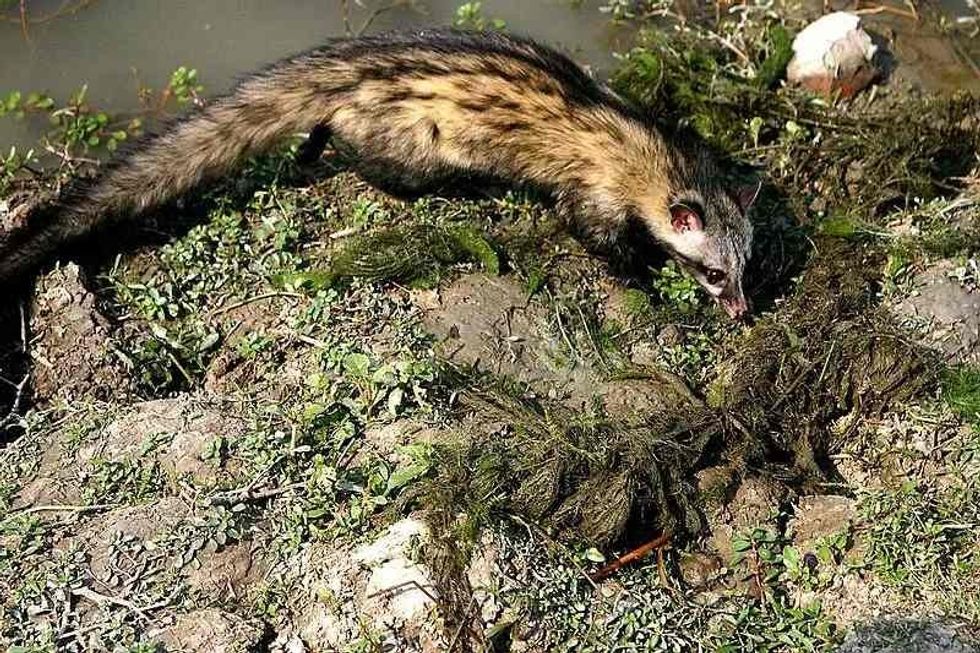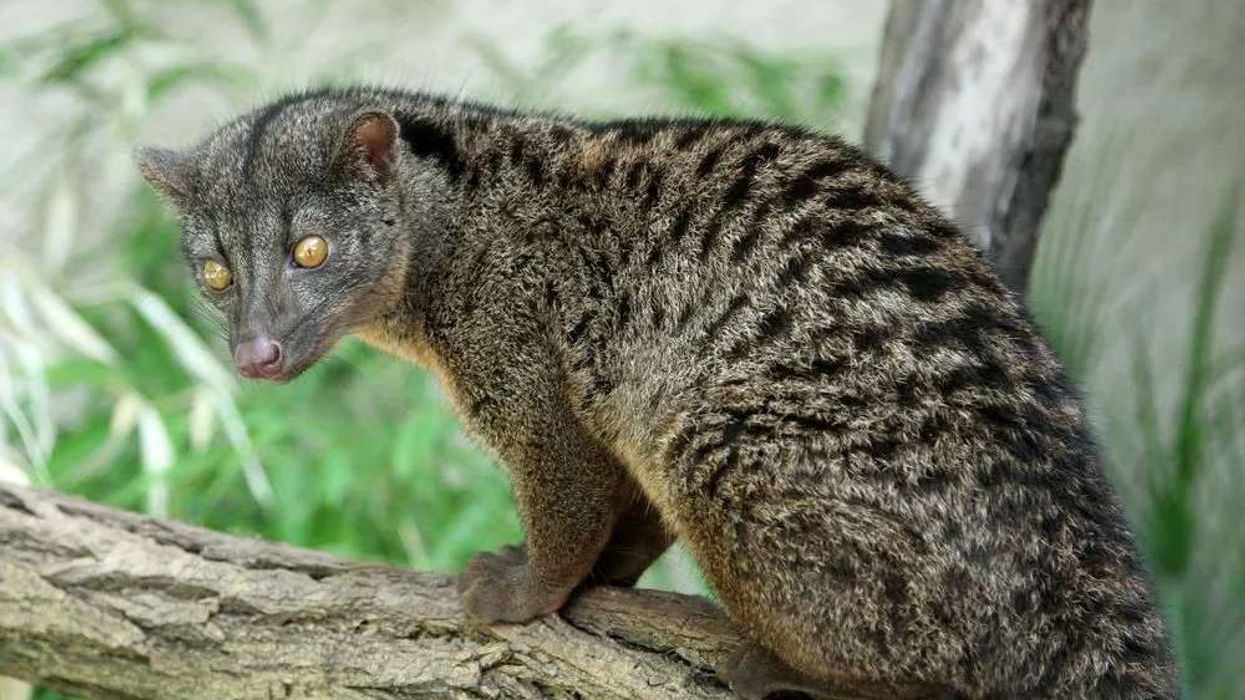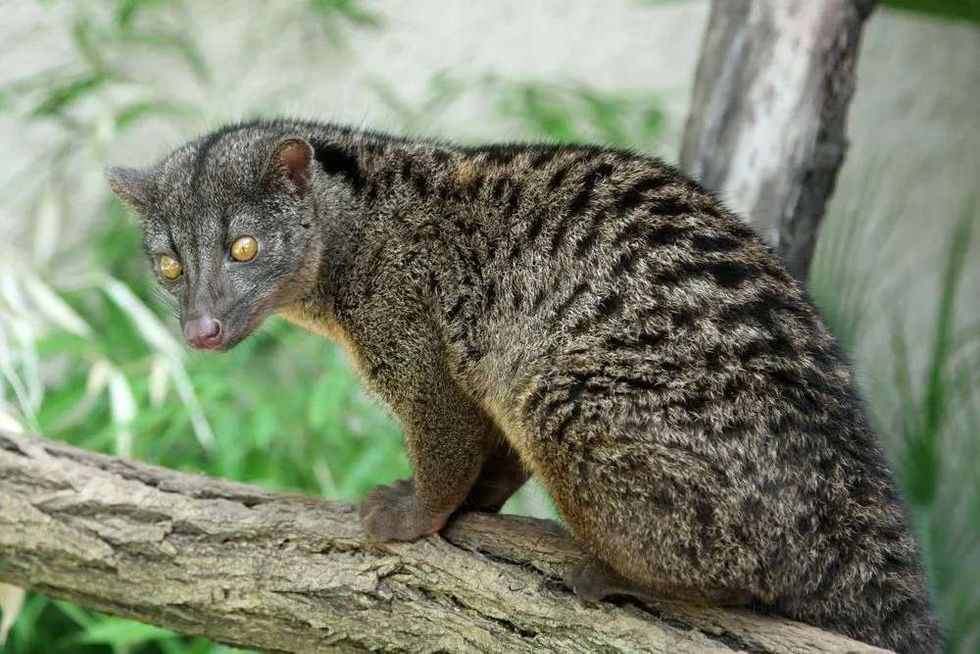Fun African Palm Civet Facts For Kids

Content
- What type of animal is an African Palm Civet?
- What class of animal does an African Palm Civet belong to?
- How many African Palm Civets are there in the world?
- Where does an African Palm Civet live?
- What is an African Palm Civet's habitat?
- Who do African Palm Civets live with?
- How long does an African Palm Civet live?
- How do they reproduce?
- What is their conservation status?
- What do African Palm Civets look like?
- How cute are they?
- How do they communicate?
- How big is an African Palm Civet?
- How fast can an African Palm Civet move?
- How much does an African Palm Civet weigh?
- What are their male and female names of the species?
- What would you call a baby African Palm Civet?
- What do they eat?
- Are they dangerous?
- Would they make a good pet?
- Did you know...
- How does an African Palm Civet protect itself?
- Different types of Civets
Is it a cat? Is it a mongoose?
No, it is the African Palm Civets!
Forever being mistaken for being an African Palm cat, or a plain old Mongoose, these animals form one of the major species in the African forest.
The habitat of these animals is over several areas, such as trees, tall shrubbery, where they can be found eating fruit, with their lithe body, and many of the family spread across trees, enjoying their own diet which can have fruit, but this diet also includes frogs, lizards, and occasionally, birds.
Although they are largely peaceful animals, content to live out their years in trees, with their omnivorous diet and nocturnal schedule, natives of the area usually take the great issue of these animals being in and around their own habitat.
As such, the poor African Palm Civets have been hunted for their meat, used in ritual sacrifices, as well as killed because they are seen as pests.
Although, despite this, they have managed to largely maintain their habitat in the trees for several years and decades, and still not low enough in population to raise concern.
Do you want to know more about this fruit-eating, nocturnal animal? Then read on! If you want to have more information on other species of animals than the Palm Civet (African), then you must absolutely check out bharal and gerenuk.
African Palm Civet Interesting Facts
What type of animal is an African Palm Civet?
The African Palm Civet (Nandinia binotata) is a type of feliform mammal. Their closest relatives are the mongoose who also belong to the phylum Chordata.
What class of animal does an African Palm Civet belong to?
The African Palm Civet (Nandinia binotata) belongs to the mammal class and phylum Chordata. Many have mistaken The Palm Civet - Cat, but that is simply not true. It is also been misnomered as a mongoose, which is also incorrect. One of the most interesting African Palm Civet facts is that it is in a family of its own.
How many African Palm Civets are there in the world?
Due to largely varying numbers, there is no consensus on the population of the African Palm Civet (Nandinia binotata). However, they have been known to have high success rates in breeding. At the same time, they are also hunted brutally, with over 3,600 killed on an annual basis by the locals of the lands in Africa they reside in.
Where does an African Palm Civet live?
The African Palm Civet habitat is in the deserts of Sub-Saharan Africa. They live in the uppermost canopy of trees, spending their days resting on large branches, only coming out during the night.
You will rarely find them close to the floor of the jungles or savannas since they have a lot of natural predators on the ground. They conserve their energy through other ways too, such as having small ears, which helps them stay cool.
What is an African Palm Civet's habitat?
They can be found in a lot of deserts, rainforests, as well as logged woodlands which go up to 8500 ft above sea level. Some of the countries it is found in are Guinea, Angola, Zimbabwe, and South Sudan.
They are also endemic to African, meaning they can not be found naturally anywhere else in the world. There had been some attempts to help them acclimatize to other warm nations such as those in South East Asia but failed.
Who do African Palm Civets live with?
The West African Palm Civet somewhat territorial, with males and females both having territories of up to a mile. In order to keep their areas separate, they living alone. These animals are not usually aggressive in terms of characteristics but an animal of this species can become aggressive and territorial for their areas during breeding seasons.
How long does an African Palm Civet live?
The African Palm Civet lifespan is up to 15-20 years. The life span years can vary depending on whether they live in the forests or the savanna, what is their diet, what are the foods they eat in said forests, and other characteristics.
How do they reproduce?
The African Palm Civets undergo reproduction with each other, and the female gives birth twice a year.
One is during the peak of the wet season, and the other is the start of the dry season. Once the reproduction has taken place, there is a gestation period of three months, wherein the females will be in the forest, on top of the higher trees.
The Palm African Civets' babies then feed on a yellow-orange liquid that comes from the female African Palm Civet's mammary glands, and it takes them several months to be independently functional.
What is their conservation status?
The IUCN Red list marks the African Palm Civet species as Least Concern. Also called the Two Spotted Palm Civet, these animals are locally abundant and found easily in their native forests in Africa. Although, due to a lot of human-related reasons, the Civet (African Palm) are now losing their homes and lives.
African Palm Civet Fun Facts
What do African Palm Civets look like?
One of the African Palm Civet's many distinguishing characteristics is its dense brown to light-tan to yellow hair that is mottled with a pattern of darker brown dots. The civet's fur is darkest on the top half of its body, allowing it to blend in with the foliage.
They also have a very long tail. This tail can be as long as their own bodies.
The civet is a small animal, with short legs, small ears, and two prominent dots upon its body, earning the animal the name of the Two Spotted Palm Civet, and scientifically called the Nandinia binotata. They also have slitted corneas in yellow-green eyes.

*Please note, this is an image of a palm civet, not an African palm civet. If you have an image of an African palm civet, let us know at hello@kidadl.com.
How cute are they?
When you look at the Eastern African Palm Civet and its face, it looks like a small raccoon! This makes them a very cute civet species indeed, but you should approach these mammals with caution, as the Civet (African Palm) can attack at a moment's notice.
How do they communicate?
The Eastern African Palm Civet communicates with a loud 'hoo' sound that carries across a lot of distance, with the average being one mile. When in the vicinity of one another, the African Palm Civets communicate by body language.
These mammals also have glands that disperse a strong-smelling liquid. The African Palm Civets will then rub their glands all over their territory, and the glands will then mark it with the scent.
How big is an African Palm Civet?
The African Palm Civet size range can be between 15-25 in, which means that it is one of the biggest civet species. In terms of the size range, then, they are twice as large as the Small Indian Civet. Though only one of them belongs to the family Nandiniidae, and it is the African Palm Civets.
How fast can an African Palm Civet move?
Due to lack of research, no one knows how fast the African Palm Civet can move. However, African Palm Civets also called the Two Spotted Palm Civet, are excellent tree climbers, and can be found spending a lot of their time snoozing in the forests!
In addition to climbing, the African Palm Civets are also excellent swimmers. Not only does the Palm Civet (African) have partially webbed toes, they also have fur that repels water.
How much does an African Palm Civet weigh?
The African Palm Civet weighs can have a range between 2.5-7 lb. Although, this range may fluctuate as they go through life since the weight range of pregnant females is more than this.
What are their male and female names of the species?
There is no fixed name for the male and female of the African Palm Civet.
What would you call a baby African Palm Civet?
There is no fixed name for the baby civets of the Nandinia binotata or the baby African Palm Civet. As this species grows up, they start establishing their areas in the forests, usually working their way to a mile or more.
What do they eat?
The African Palm Civet (also called the Nandinia binotata) is an omnivore and as such, both plants, fruit, and animals can be considered food for this animal. The African Palm Civet diet includes fruits such as papaya, banana, and more.
They also eat lizards, frogs, and birds as food. Since they have fruits included in their diets, they can sometimes be seen as pests by locals in the area, who then, in an attempt to curb their population, kill them for bushmeat.
Are they dangerous?
Yes, the African Palm Civet can be dangerous because of their status as predators. They usually avoid contact in the savanna or the forest, but if threatened or cornered, or if you attempt to take their food, the African Palm Civet will attack.
Otherwise, this species of predators are not dangerous, and moreover, in need of conservation (even though it is of Least Concern at the moment.)
Would they make a good pet?
No, the African Palm Civet as a pet is a bad idea for various reasons. First, all civets, including the African Palm Civet, are not allowed inside several countries for fear of the SARS Virus.
In addition, the African Palm Civet can be a very destructive animal in captivity, making it a poor species to have as pets. They also have very short legs and small ears which make this species unsuitable for any other biome than the deserts and forests in Africa.
Did you know...
One of the major reasons for the population decline of the African Palm Civet is their relation to the native population in the savanna. They are not only sold as bushmeat but they are also hunted as pests, as well as used for ritual sacrifice purposes.
The native population of these places believes the African Palm Civet is dangerous to their crops and children.
But there are some good things to know about the African Palm Civets too! It is that they are so extensive and locally abundant that they are well-known and also called the Two-Spotted palm civet. They are called the Two Spotted Palm Civet because of their prominent spots on their body.
You might also be wondering, how did the African Palm Civet get its name?
Though its common moniker the African Palm Civets stuck quite easily, there is a long history to how this species got its taxonomical name. The first time the African Palm Civet was named, it was done so by John Edward Grey in 1830 who added them to the Viverra binotata.
A few years later in 1843, Grey added the African Palm Civets to the genus Nandinia.
However, late in 1929, almost a century after its original name to the order, Reginald Ines added onto the genus Nandinia, suggesting that the African Palm Civets be put in family Nandiniidae, with genus Nandinia.
This is because it differed from other animals in the genus Nadinia order in terms of bone structure characteristics, which is why the African Palm Civets have their own subcategory in the genus Nadinia, called the family Nandiniidae.
Throughout this, while the order changed, their phylum remained the same.
How does an African Palm Civet protect itself?
One of the most iconic adaptations of the African Palm Civets is their dorsal crest. In addition to this African omnivores' loud calls to ward off predators, the African Palm Civets also will raise the black hair on their dorsal crest to appear larger than their actual size, and assert their dominant status.
The civet also has evolved relatively webbed feet and waterproof fur, that allows it to swim in order to escape predators.
It has also been studied that these species did not always know how to climb and that it was a simple development they underwent in the process of evolution. In fact, some species of civets still have not developed the ability to climb. Therefore this creature is well equipped to deal with anything nature throws at it.
Different types of Civets
In addition to the African Palm Civets, there are at least 18 other types of civets. Nine of these civets live in India.
It is interesting to note that there are no species ofcCivets native to the American continent. Instead, they are only found in Southern Europe, Africa, and Asia. There are variations mostly in markings, and in sizes.
For example, the Small Indian Civet looks like a leopard with its pale yellow fur dotted with black spots. The Himalayan Civet also looks similar to the African Palm Civets, but it is too small to be one.
Therefore, civets as a species are overall found in warmer regions, in varied biomes. They however are found to favor solitary lives, territories to be in, and an inclination towards an omnivorous diet no matter where they are found.
Here at Kidadl, we have carefully created lots of interesting family-friendly animal facts for everyone to discover! Learn more about some other mammals including Pyrenean ibex, or an Asiatic lion.
You can even occupy yourself at home by drawing one on our koala coloring pages.
We Want Your Photos!
More for You
Sources
https://a-z-animals.com/animals/african-palm-civet/
https://animaldiversity.org/accounts/Nandinia_binotata/
https://kidskonnect.com/animals/african-palm-civet/
https://animals.fandom.com/wiki/African_Palm_Civet
See All
Bachelor of Arts specializing in English Language, Master of Philosophy

Devangana RathoreBachelor of Arts specializing in English Language, Master of Philosophy
Devangana is a highly accomplished content writer and a deep thinker with a Master's degree in Philosophy from Trinity College, Dublin. With a wealth of experience in copywriting, she has worked with The Career Coach in Dublin and is constantly looking to enhance her skills through online courses from some of the world's leading universities. Devangana has a strong background in computer science and is also an accomplished editor and social media manager. Her leadership skills were honed during her time as the literacy society president and student president at the University of Delhi.
Bachelor of Business Management

Yashvee PatelBachelor of Business Management
Yashvee has won awards for both her writing and badminton skills. She holds a business administration honors degree and has previously interned with social media clients and worked on content for an international student festival. Yashvee has excelled in academic competitions, ranking in the top 100 in the Unified International English Olympiad and placing second in an essay-writing competition. Additionally, she has won the inter-school singles badminton title for two consecutive years.
Disclaimer
1) Kidadl is independent and to make our service free to you the reader we are supported by advertising. We hope you love our recommendations for products and services! What we suggest is selected independently by the Kidadl team. If you purchase using the Buy Now button we may earn a small commission. This does not influence our choices. Prices are correct and items are available at the time the article was published but we cannot guarantee that on the time of reading. Please note that Kidadl is a participant in the Amazon Services LLC Associates Program, an affiliate advertising program designed to provide a means for sites to earn advertising fees by advertising and linking to Amazon. We also link to other websites, but are not responsible for their content.
2) At Kidadl, we strive to recommend the very best activities and events. We will always aim to give you accurate information at the date of publication - however, information does change, so it’s important you do your own research, double-check and make the decision that is right for your family. We recognise that not all activities and ideas are appropriate for all children and families or in all circumstances. Our recommended activities are based on age but these are a guide. We recommend that these ideas are used as inspiration, that ideas are undertaken with appropriate adult supervision, and that each adult uses their own discretion and knowledge of their children to consider the safety and suitability. Kidadl cannot accept liability for the execution of these ideas, and parental supervision is advised at all times, as safety is paramount. Anyone using the information provided by Kidadl does so at their own risk and we can not accept liability if things go wrong.
3) Because we are an educational resource, we have quotes and facts about a range of historical and modern figures. We do not endorse the actions of or rhetoric of all the people included in these collections, but we think they are important for growing minds to learn about under the guidance of parents or guardians.







